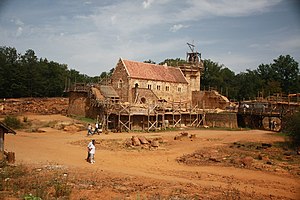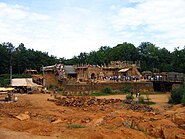| Guédelon Castle | |
|---|---|
|
Château de Guédelon | |
| Near Treigny, Yonne, Burgundy, France | |
 Guédelon castle in August 2012 | |
| Type | Castle |
| Site information | |
| Owner | Michel Guyot (first owner) |
| Open to the public | Yes |
| Condition | In construction |
| Site history | |
| Built | 1997-2022? |
| Built by | Jacques Moulin (architect) |
| Materials | Medieval materials: wood, stone, lime,... |
Guédelon Castle is a medieval construction project located in Treigny, France. The object of the project is to build a castle using only the techniques and materials used in the Middle Ages. When completed in the 2020s, it should be an authentic recreation of a 13th-century medieval castle.
In order to fully investigate the technology required in the past, the project is using only period construction techniques, tools, and costumes. Materials, including wood and stone, are all obtained locally. Jacques Moulin is the chief architect for the project. He designed the castle according to the architectural model developed during the 12th and 13th centuries by Philip II of France.
Construction started in 1997 under Michel Guyot, owner of the nearby Saint-Fargeau castle. The site was chosen according to the availability of construction materials: an abandoned stone quarry, in a large forest, with a pond close by.
The project has created 55 jobs and is now a tourist destination, with more than 300 000 visits each year.
Concept[]
The original idea of building from scratch a 13th-century-style castle came to Michel Guyot while restoring his Saint-Fargeau property. It matured to become a complex project focusing on several aspects:
- Tourism: The construction site can be visited. Guided tours are organised and a medieval restaurant welcomes visitors. The site is now a major tourist destination, being the most visited tourist attraction in Yonne, with more than 300,000 visitors in 2010.
- Education: The project is open and adapted to groups and school excursions. One can learn about work conditions in the Middle Ages and the different professions of the time.
- Science and knowledge: The project team uses and tests scientists' and historians' knowledge of medieval construction techniques.
- Human: In this rural and isolated area, the project created 45 jobs and attracted 200 volunteers.
- Social: The site employs youths facing difficulties, helping them through on-the-job professional training. For example, some of them obtained stonemasonry certifications.
- Memorial: The project can be seen as a major memorial site.
Intent[]
Experimental archaeology employs a hands-on approach of testing methods to rediscover forgotten techniques. It was initiated when academics decided to experiment and learn by themselves the old skills, rather than relying merely on models, hypotheses, and theories. Another example of this approach is the attempts by archaeologists to create flint tools.
When ethnographic research is not possible, only archaeological materials and old manuscripts can help. But this creates an interpretation bias. To understand how to use a tool, how to create an object, an actual reproduction becomes necessary. This leads to the creation of swords, siege engines, Roman fortification, etc. The purpose is not only to learn how to fabricate the object, but also to learn how to use it.
For the Middle Ages, this approach was limited to isolated objects, specific functions, and limited sequences. The intent of Guédelon castle is to generate a completely new experiment: the analysis of construction in action, as a whole project.
Bibliography[]
- Thomas Bitterli-Waldvogel: Guédelon. Bau einer Burg im 21. Jahrhundert. In: Burgen und Schlösser. Zeitschrift für Burgenforschung und Denkmalpflege. Heft 4, 2006. Braubach, Europäisches Burgeninstitut.
- Philippe Minard und François Folcher: Guédelon: Des hommes fous, un château fort. Paris: Aubanel, 2003.
- Richard Utz: "'There Are Places I Remember:' Situating the Medieval Past in Postmedieval Memory." Transfiguration: Nordic Journal of Christianity and the Arts 6.2 (2007), 89-108.
See also[]
- Ozark Medieval Fortress - another, similar project in Arkansas, USA
Construction Images[]
External links[]
- (French) Official site for the project
- (English) Official site, english version
- (French) Dossier Futura-Sciences article Guédelon : renaissance d'un château médiéval
- (French) Guedelon construction photos
- (English) BBC News article.
- "Building the Great Cathedrals". NOVA. 2010-10-19. http://www.pbs.org/wgbh/nova/ancient/building-gothic-cathedrals.html. Retrieved 2010-10-20.
- Guedelon 360°-Panoramatour - Aug.2011
The original article can be found at Guédelon Castle and the edit history here.







